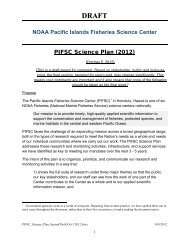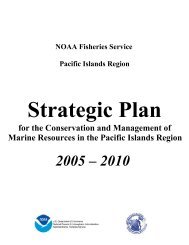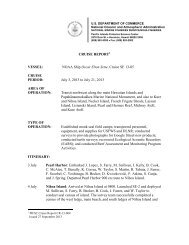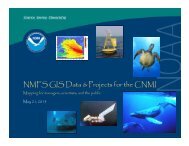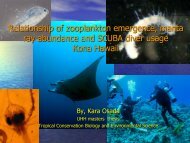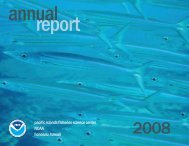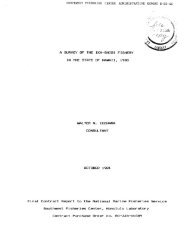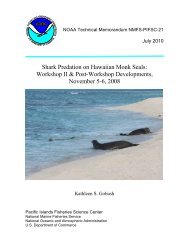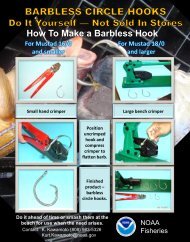Contingency Plan for Hawaiian Monk Seal Unusual Mortality Events
Contingency Plan for Hawaiian Monk Seal Unusual Mortality Events
Contingency Plan for Hawaiian Monk Seal Unusual Mortality Events
You also want an ePaper? Increase the reach of your titles
YUMPU automatically turns print PDFs into web optimized ePapers that Google loves.
A-3<br />
1. If endoparasites are observed, collect immediately. Rinse, relax, fix, and store as described in<br />
the parasitology section below. Be sure parasites are assigned the same specimen number as the<br />
scat from which it is derived, but give each specimen a unique specimen sub-number.<br />
2. Collect entire scat (or what's remaining if sub-sample(s) <strong>for</strong> parasitology are taken) in whirlpaks<br />
or ziplocs. Be sure to include legible specimen labels both inside (using waterproof labels) and<br />
outside the bags. Take care to ensure that the inside labels are visible from the outside.<br />
3. Once any parasitology sub-samples have been collected, add 20% liquid detergent, 80% sea<br />
water solution to scat sample to begin the degreasing process and to kill some of the pathogens.<br />
Add just enough of this solution to keep samples moist. Remove as much air as possible from bags<br />
be<strong>for</strong>e storing them in buckets. Be sure the samples are stored double bagged and are kept upright<br />
in buckets to prevent leaks.<br />
B. SPEWS<br />
Spews (vomitus) are collected <strong>for</strong> prey species determination and parasite studies. They may also be used<br />
to detect ciguatera (a naturally occurring biotoxin found in dinoflagellates) in tissues of certain prey<br />
species. Spews are often found near seal haul out tracks and may contain partially digested eels, fish,<br />
lobster carapaces, octopus, or whole prey items. Note: seabirds also spew squid, flying fish, and other prey<br />
species, so be sure to closely observe seal tracks in the area the spew is found and collected.<br />
1. If endoparasites are observed in the spew, collect them immediately and preserve as described in<br />
the parasitology section below. Be sure parasites are assigned the same specimen number as the<br />
spew from which it was derived, but give each specimen a unique specimen sub-number.<br />
2. Next, collect a representative sub-sample of spew that is about 300-400 gm (100 gm is<br />
approximately hamburger sized) <strong>for</strong> ciguatera analysis. Once the representative sample is<br />
collected, split this sub-sample up into ~50 gm units and place in whirlpaks. Assign this spew subsample<br />
the same specimen number as the spew from which it was derived, but give only ONE<br />
unique specimen SUB-number to the representative sample, even though it is being split into<br />
multiple bags. In addition to recording specimen number and sub-number on inner and outer<br />
labels, note bag number and total number of bags <strong>for</strong> one sub-sample on each individual bag (1 of<br />
5, 2 of 5, etc.) Be sure to also record the total number of bags <strong>for</strong> one spew sub-sample in the<br />
"notes" field of the specimen collection summary <strong>for</strong>m. NOTE: the splitting of the sample is<br />
necessary to store the samples in liquid nitrogen. BE SURE the split samples will fit easily into<br />
and out of the liquid nitrogen dewar. It can be very difficult, if not impossible, to remove large<br />
items from the dewars due to their internal design.<br />
3. Once any parasites sub-samples and the ciguatera sub-sample have been collected, store<br />
remaining spew DRY in a whirlpak or ziplock, double bagged. Clearly label the outside of the<br />
bag. Be sure to also include a legible specimen label inside (using waterproof labels) the bag.<br />
Arrange the inside label so that it is visible from the outside. No preservation is necessary. Be<br />
sure that the specimen is packed so that it is stored upright in buckets <strong>for</strong> storage and<br />
shipment.<br />
C. PARASITES<br />
Polyvinyl Alcohol (PVA) fixed fecal specimens: Collect a minimum of 10 and a maximum of 30 PVA<br />
fixed scat samples from fresh scats from known animals. Collection ef<strong>for</strong>ts should be focused on samples<br />
from juvenile animals and collection of repeat samples from the same individuals.



